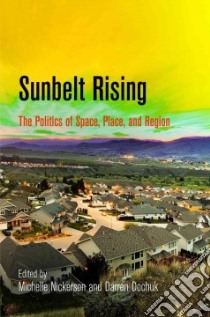Sunbelt Rising - 9780812223002
Un libro in lingua di Nickerson Michelle (EDT) Dochuk Darren (EDT) edito da Univ of Pennsylvania Pr, 2014
- € 27.10
- Il prezzo è variabile in funzione del cambio della valuta d’origine
Coined by Republican strategist Kevin Phillips in 1969 to describe the new alloy of conservatism that united voters across the southern rim of the country, the term "Sunbelt" has since gained currency in the American lexicon. By the early 1970s, the region had come to embody economic growth and an ambitious political culture. With sprawling suburban landscapes, cities like Atlanta, Dallas, and Los Angeles seemed destined to sap influence from the Northeast. Corporate entrepreneurialism and a conservative ethos helped forge the Sunbelt's industrial-labor relations, military spending, education systems, and neighborhood development. Unprecedented migration to the region ensured that these developments worked in concert with sojourners' personal quest for work, family, community, and leisure. In the resplendent Sunbelt the nation seemed to glimpse the American Dream remade.
The essays in Sunbelt Rising deploy new analytic tools to explain this region's dramatic rise. Contributors to the volume study the Sunbelt as both a physical entity and a cultural invention. They examine the raised highway, the sprawling prison complex, and the fast-food restaurant as distinctive material contours of a region. In this same vein they delineate distinctive Sunbelt models of corporate and government organization, which came to shape so many aspects of the nation's political and economic future. Contributors also examine literature, religion, and civic engagement to illustrate how a particular Sunbelt cultural sensibility arose that ordered people's lives in a period of tumultuous change. By exploring the interplay between the Sunbelt as a structurally defined space and a culturally imagined place, Sunbelt Rising addresses longstanding debates about region as a category of analysis.
Published in cooperation with the William P. Clements Center for Southwest Studies, Southern Methodist University.
Informazioni bibliografiche
- Titolo del Libro in lingua: Sunbelt Rising
- Sottotitolo: The Politics of Place, Space, and Region
- Lingua: English
- Autori : Nickerson Michelle (EDT) Dochuk Darren (EDT)
- Editore: Univ of Pennsylvania Pr
- Collana: Univ of Pennsylvania Pr (Paperback)
- Data di Pubblicazione: 05 Marzo '14
- Genere: POLITICAL SCIENCE
- Pagine: 470
- Dimensioni mm: 228 x 152 x 0
- EAN-13: 9780812223002


